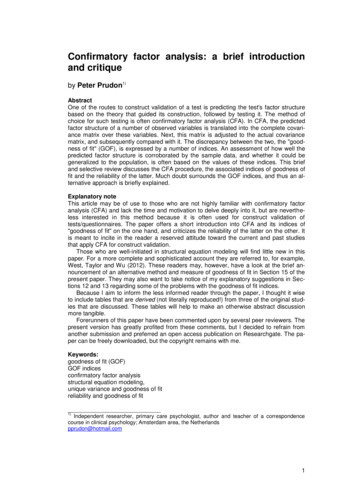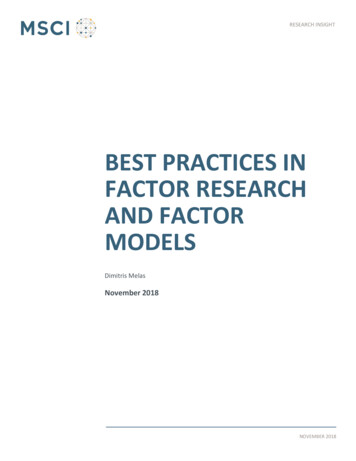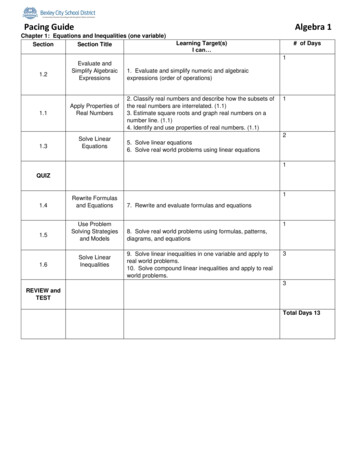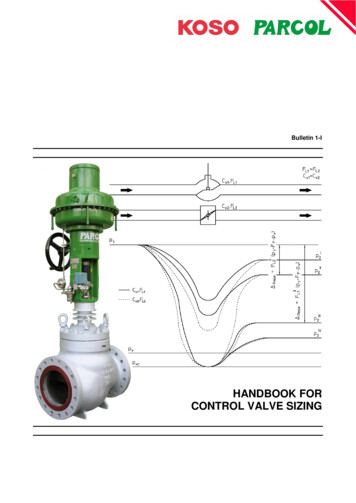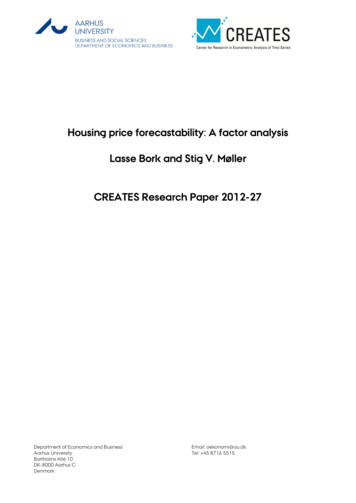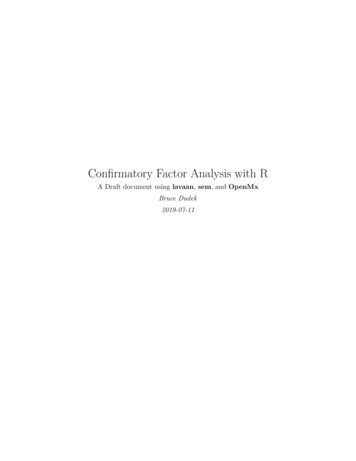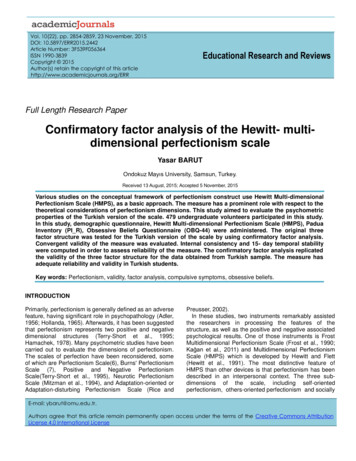
Transcription
Vol. 10(22), pp. 2854-2859, 23 November, 2015DOI: 10.5897/ERR2015.2442Article Number: 3F539F056364ISSN 1990-3839Copyright 2015Author(s) retain the copyright of this nal Research and ReviewsFull Length Research PaperConfirmatory factor analysis of the Hewitt- multidimensional perfectionism scaleYasar BARUTOndokuz Mayıs University, Samsun, Turkey.Received 13 August, 2015; Accepted 5 November, 2015Various studies on the conceptual framework of perfectionism construct use Hewitt Multi-dimensionalPerfectionism Scale (HMPS), as a basic approach. The measure has a prominent role with respect to thetheoretical considerations of perfectionism dimensions. This study aimed to evaluate the psychometricproperties of the Turkish version of the scale. 479 undergraduate volunteers participated in this study.In this study, demographic questionnaire, Hewitt Multi-dimensional Perfectionism Scale (HMPS), PaduaInventory (PI R), Obsessive Beliefs Questionnaire (OBQ-44) were administered. The original threefactor structure was tested for the Turkish version of the scale by using confirmatory factor analysis.Convergent validity of the measure was evaluated. Internal consistency and 15- day temporal stabilitywere computed in order to assess reliability of the measure. The confirmatory factor analysis replicatedthe validity of the three factor structure for the data obtained from Turkish sample. The measure hasadequate reliability and validity in Turkish students.Key words: Perfectionism, validity, factor analysis, compulsive symptoms, obsessive beliefs.INTRODUCTIONPrimarily, perfectionism is generally defined as an adversefeature, having significant role in psychopathology (Adler,1956; Hollanda, 1965). Afterwards, it has been suggestedthat perfectionism represents two positive and negativedimensional structures (Terry-Short et al., 1995;Hamachek, 1978). Many psychometric studies have beencarried out to evaluate the dimensions of perfectionism.The scales of perfection have been reconsidered, someof which are Perfectionism Scale(6), Burns' PerfectionismScale (7), Positive and Negative PerfectionismScale(Terry-Short et al., 1995), Neurotic PerfectionismScale (Mitzman et al., 1994), and Adaptation-oriented orAdaptation-disturbing Perfectionism Scale (Rice andPreusser, 2002).In these studies, two instruments remarkably assistedthe researchers in processing the features of thestructure, as well as the positive and negative associatedpsychological results. One of those instruments is FrostMultidimensional Perfectionism Scale (Frost et al., 1990;Kağan et al., 2011) and Multidimensional PerfectionismScale (HMPS) which is developed by Hewitt and Flett(Hewitt et al., 1991). The most distinctive feature ofHMPS than other devices is that perfectionism has beendescribed in an interpersonal context. The three subdimensions of the scale, including self-orientedperfectionism, others-oriented perfectionism and sociallyE-mail: ybarut@omu.edu.tr.Authors agree that this article remain permanently open access under the terms of the Creative Commons AttributionLicense 4.0 International License
Barutprescribed perfectionism contain overvaluation related-toexpectations from other individuals. Frost reported thefact that there are drastically similarities between thestructures of measurements of two psychometric devices.In this study, it is revealed that socially prescribedperfectionism is especially related to negative emotions(Frost et al., 1993).The first translation of HMPS into Turkish was done byOral (1999). In this first study, factorial structure of thescale was evaluated by using factor analysis, and a factorsimilar to the original structure with three factors hasbeen obtained. However, it is thought that the newtranslation is needed because of the academic-demandfor the modification of HMPS in terms of someterminology. The sub-meters of Self-oriented, Othersoriented perfectionism, socially prescribed perfectionismhave been calculated with internal consistency quotientsas 91, 73 and 80, respectively.Perfectionism is an important psychological construct.However, increased levels of perfectionism are found inanorexia nervosa (Bastiani et al., 1995), bulimia nervosa(Vohs et al., 1999), social phobia, panic disorder(Saboonchi and Lundh, 1999), anxiety (Klibert et al.,2005; Stober, 1998), depression (Rice and Dellwo, 2001),chronic insomnia (Vincent and Walker, 2000), suicidalideation (Hamilton and Scheitzer, 2000), and obsessivecompulsive disorder (Frost et al., 1990). Currently, theconstruct of perfectionism is defined and measured indifferent ways by different researchers. It appears tosuffer from both jingle and jangle fallacies (Block, 1995).The Hewitt Multidimensional Perfectionism Scale(HMPS), the measure of perfectionism developed byHewitt and Flett (1991), is composed of three subscales.Self-oriented perfectionism refers to the tendency to sethigh standards, strictly evaluate behavior, and to havemotivation to attain perfection. There is, of course, somecovariation between scores of measures of these twoinstruments. Self-oriented perfectionism appears similarto the personal standards and organization subscales ofthe FMPS (Shafran and Mansell, 2001), and has beenfound to have large correlations with personal standards(.61 to .62). But, it has only small correlations withorganizations (.26-.29) (Flett et al., 1995; Frost et al.,1993).In many studies, HMPS has been applied to evaluatethe level of perfectionism and to reveal the sandperfectionism. The fact that psychometric features of thescale are not taken into consideration enough, in thisstudy, psychometric features of HMPS are modified inthis sense. Researchers show that perfectionism isrelated to the fear of making mistakes, and gettingcriticism has an important role in obsessive compulsivedisorder. Cognitive features play role in ObsessiveCompulsive Disorder (OCD). A number of researchersdefine perfectionism as a cognitive distortion that shouldnot be underestimated (Ashby and Bruner, 2005;Freestone et al., 1996; Obsessive-Compulsive Cognitions2855Working Group Assessment of Obsessive-CompulsiveDisorder, 1990; Obsessive-Compulsive CognitionsWorking Group, 2005). Although perfectionism fromdifferent approaches has been scrutinized in differentmanners, we confront this cognitive feature forebodingwith the efforts of taking precautions to avoid ambiguityand negative statements in OCD as a leading factor(Frost et al., 2003). In order to evaluate the validity ofHMPS together, sub-meters of the instruments wereregarded with the indication of obsessive compulsion andbeliefs. The reliability, internal consistency andsustainability for 15 days of the device are evaluated bycalculations.METHODSResearch questions1. Are psychometric features of HMPS aimed to be modified in thissense?2. Are the psychometric features of multi-dimensional perfectionismscale related to item statistics measured?3. Is the total-item correlation for self-oriented perfectionism subscale high?Participants479 undergraduate students studying at Ondokuz Mayıs University(OMU) were involved in this research. 72.86% of the participantswere female students (n 349). The participants come from lowincome class (n 22), middle income class (n 413), and highincome class (n 44) families, which are respectively 4.59, 86.22and 9.19%.Educational background of the fathers of the participants isdistributed as: 0.42%, illiterate (n 2); 2.71%, literate (n 13);27.97%, graduated from primary school (n 134); 16.91%, graduatedfrom secondary school (n 81); 26.93%, graduated from high school(n 126), and 25.05% fathers who have bachelor or master degree(n 120); educational background of the mothers of the participantsare distributed as: 7.93% illiterate (n 38), 5.85% literate (n 28),49.69% graduated from primary school (n 238), 12.73% graduatedfrom secondary school (n 61), 16.49% graduated from high school(n 79), and 7.31% fathers have bachelor or master degree (n 35).39.67% of the participants’ residents were rural areas.InstrumentsHewitt Multidimensional Perfectionism Scale (HMPS)HMPS developed to measure the level of perfectionism and having45 items for self-evaluation has three sub-meters: Self-orientedperfectionism, others-oriented perfectionism and socially prescribedperfectionism. The consistencies of the device for self-orientedperfectionism, other-oriented perfectionism, and socially prescribedperfectionism are between 86-88, 74-82, and 81-87, respectively(Hewitt et al., 1991).Padua Inventory Revise (PI-R)It is a scaling device with a test composed of 41 questions. It is
2856Educ. Res. Rev.Table 1. Descriptive statistic of item.IndividualisticrλITEM 1.60.65ITEM 6.69.75ITEM 8.50.52ITEM 12.62.62ITEM 14.72.79ITEM 15.80.85ITEM 17.72.80ITEM 20.34.36ITEM 23.30.34ITEM 28.75.80ITEM 32.52.53ITEM 34.38.37ITEM 36.45.42ITEM 40.61.62ITEM 42.60.64ExtrovertnessRITEM 2.24ITEM 3-,03ITEM 4.01ITEM 7.38ITEM 10.33ITEM 16.32ITEM 19.37ITEM 22.35ITEM 24.35ITEM 26.43ITEM 27.45ITEM 29.42ITEM 38.23ITEM 43.24ITEM 4.15Socially AttributedrITEM 5.18ITEM 9.25ITEM 11.38ITEM 13.45ITEM 18.38ITEM 21.20ITEM 25.20ITEM 30.12ITEM 31.48ITEM 33.39ITEM 35.56ITEM 37.23ITEM 39.48ITEM 41.53ITEM -,01r total item Correlations; λ item factor loadingsdeveloped for evaluating the intensity of the indication of Obsessivecompulsive disorder (Sanavio, 1988).The scaling device has 5 subgroups as drives, cleanliness, control, contemplation and certainty.It is declared that Turkish form of the device has high applicabilityand reliability (Besiroğlu et al., 2005).Obsessive Beliefs Questionnaire (OBQ-44)It is a scaling device composed of 44 questions and developed toevaluate cognitive features, which play an important role inrevealing the indication of obsessive compulsive (ObsessiveCompulsive Cognitions Working Group, 2005). The device hasthree sub groups as; expectation of responsibility/danger,perfectionism/certainty, and control of importance/thoughts. It isdeclared that Turkish form of the device has high applicability andreliability (Besiroğlu et al., 2005).Statistical analysisIllustrations concerning descriptive statics have been calculated.Afterwards, total item correlations related to the sub-groups ofscaling devices were acquired. The validity of the structure oforiginal factor with three factors on data, acquired from Turkishstudents, was evaluated by using verification of factor analysis. Thesub-factors of scaling device were regarded together withobsessive compulsive and obsessive beliefs whether it is valid.Reliability of the device was evaluated by calculating internalconsistency and the correlation between two applications, whichwere done with fifteen days break.ProcessThe translation of the scaling device into Turkish has been done bytwo full-fledged academic having sufficient knowledge of English.This ongoing study was announced to students with the help ofprofessors at different faculties of Ondokuz Mayis University. Willingstudents participated in the research after class time, and after thatthe aim of the study and general context were explained.Applications were done after students gave their written permission.Duration of the application lasted for 35-45 min.RESULTSIn order to evaluate the psychometric features of multidimensional perfectionism scale, related item statisticswere measured. According to the sub-scale of theinstrument total item correlations were gathered ininstrument, total-item correlations for self-oriented itself.The total-item correlation for self-oriented perfectionismsub-scale is found to be high.The correlation for other-oriented perfectionism subscale is sufficient. It was found that the distinct activelevel of 3rd and 4th items is low. Although the socialimplied perfectionism is low, the level of coefficients of theother- items are acceptable. Total-ITEM correlations aregiven in Table 1.After item correlations, the validity of the originals of thethree-itemed structure of the assessment instrument inTurkish sample was tested by confirmatory factoranalysis. The x2 Satorra-Bentler value scale of degreesof freedom of 941 is 3098.23; which was calculated forthe original structure with three factors. The square rootrelated to the mode is 0.69 (confidence interval, 0670.72); increasing fit index is 89; comparative fit index is89 and standardized square root of error mean square is82. For the model, 3 errors covariance was added by theresult of the statistics of Wald using Ligrel package.Between items 30 and 44 (Q 33; p 01), items 3 and 43(Q 50 p 01) and 8 and 12 (Q 29; p 01) error covariance
Barut2857Table 2. Pearson Responsibility/danger olling **.42**.18**Socially *:p .05; **:p .01.was added. Scale x2 value of 930 degrees of freedomrelated to the estimated model is 2927.47 with threeparameters added. The square root of error mean squareof the calculated proximity related to the model is 0.67(90% confidence interval 064-069); increasing fit index is90, comparative fit index is 90 and standardized squareroot of error mean square is 81. The gathered resultsreveal that the three-factor structure of HMDPS isconvenient for the data gathered from Turkish (Hu andBentler, 1999). The likelihood predictions gained for theitems are given in Table 2.The inter-validity of the assessment instrument wasmeasured by calculating the person product – momentcorrelation coefficient measured by Pandus inventory andsub-scale of obsessive beliefs scale as the correlationcoefficients of the criterion was considered. There is nostrong correlation between self-oriented perfectionismand others-oriented perfectionism sub-scales of the multidimensional perfectionism scale. On the other hand, itwas found that it is inter-relating with the levels fromlowest level to average level. Some correlationcoefficients of the criterion in various levels from middleto high are calculated between the subscales of multidimensional perfectionism scale and obsessive cognitivebelief areas. Particularly, strong correlation rfectionism scale is enabled. Obtained person productmoment correlation coefficients are given in Table 2.The correlations between the sub-scale of HMDPS aremeasured as such: r 54 (p 01) between self-orientedperfectionism and other-oriented perfectionism and otheroriented perfectionism, r 35 (p 01) between self-orientedand socially Implied perfectionism and lastly, r 29 (p 01)between other-oriented and socially implied perfectionism.The test-rested correlations between the twoimplications applied to 36 people (with 15-days breakbetween the two applications and Cronbach Alfacoefficients related to three subscales of the scale inorder to make evaluations about reliability of therespective psychometric instrument. Although themeasure of inter-reliability and stability coefficients ofother-oriented perfectionism subscale were acceptable.Table 3. Internal consistency and test retest reliability.IndividualisticExtrovertnessSocially AttributedInternal consistency.84.70.73Equilibrium.82**.60**.76****:p .01.The results show that the assessment instrument has asatisfactory level of reliability coefficient of HMDPS (Table3).DISCUSSIONIn recent years, the researchers placed more emphasison perfectionism day by day which is considered as animportant personality trait. It is accepted that negativeperfectionism is related to psychopathology (Shafran andMansell, 2001). Different researchers who focus onperfectionism suggest different models about this concept(Bieling et al., 2003; Steober and Otto, 2006). It issuggested that the development of perfectionism attitudeis related to family relationships and communicationaltypes (Frost et al., 1991; Flett et al., 2002; Soenens et al.,2005). High performance standards set the stage forsome problems related to inter-personal relation andpsychosocial functionality (Flett et al., 1996; Hill and Zrull,1997). There are some researchers who suggest thatperfectionism is a personal trait that carries inter-personalproperties (Alden et al., 1994). In this context, Hewittmultidimensional perfectionism scale is an importantinstrument that enables researchers make evaluationsabout the subject, which is practical assessmentinstrument that helps with the evolution of perfectionismlevel in intrapersonal and interpersonal context. In thesestudies, the aim is to evaluate the psychometric featuresof HMDPS.The study started with the item, and analysis of thesub-scales of the instrument. When the total-item
2858Educ. Res. Rev.correlations are considered it was found that the overalltotal- item correlation is at a demanded level. After itemanalysis the validity of the original three factors wascreated in Turkish form. Among the three items in theerror Covariance analysis conducted after it has beenadded to the original three-factor structure validity, thescale model compliance values were obtained. So farmany studies that have been used for the first time onÇBMO which is made of confirmatory factor analysisresults by the proposed Tri-factor instrument developers.The correlation coefficients of the scale about theobsessive-compulsive symptoms that were calculated toevaluate the overall validity of the assessmentsinstrument show that there are low correlation amongvariables. The socially implied perfectionism sub-scalehas high correlation which is similar to obsessivecompulsive beliefs. The results show that the sociallyimplied perfectionism sub-scale has relations withnegative evaluations and symptoms, in accordance withliterature findings (Obsessive-Compulsive CognitionsWorking Group, 2005; Flett et al., 1998). Flett and Hewittstate that socially implied perfectionism is component ofthe characteristic of negative perfectionism (Flett andHewitt, 2006). Besides, perfectionism/certainty sub-scaleof obsessive beliefs scale has high correlations with allthe sub-scale of HMDPS. The gathered finding supportsthe structural validity of the scale.The coefficient of the inter-consistence which was usedto evaluate the reliability levels of the assessmentinstruments was found to be high. The 15-days stabilityfactor calculated for the sub-scales of the instrument is ata demanded level and the lowest test results were gainedfor other oriented perfectionism. Similar findings wereobtained in previous studies, as well.This study has similar limitations. Firstly this study wasconducted on university students and only different agegroups were not included in the study. Besides, thevalidity of the assessment instrument together withobsessive-compulsive symptoms was examined in thestudy. However, a clinical group was not included in thestudy to evaluate the discriminant validities. Whileinterpreting the findings these limitations should be takeninto account. It can be stated that the Turkish version ofmulti-dimensional perfectionism scale with the originalthree factorial model has a satisfying level of validity andreliability.Statics of the item related to the device has beencalculated for evaluating psychometric features ofmultidimensional perfectionism scale. According to thethree sub-meters of the device, substance total correlationin itself was acquired. It is observed that item totalcorrelation calculated for sub-meters of self-orientedperfectionism is high. Although correlations calculated forsub-meters of other-oriented perfectionism is on enoughrdthlevel, distinctive level of 3 and 4 items is found to beththvery low. Although item total correlation of 5 and 30items is low when we consider sub-meters of sociallyprescribed perfectionism, quotients at an acceptable levelwere found for other items. Item total correlations areshown in Table 1.Conflict of InterestsThe author has not declared any conflicts of interest.REFERENCESAdler A (1956). The neurotic disposition. In: H. L. Anbacher & R. R.Anbacher (Eds), the individual psychology of Alfred Adler. New York:Harper pp. 239-262.Alden LE, Bieling PJ, Wallace ü ST (1994). Perfectionism and aninterpersonal context: a self-revelation analysis of dysphoria andsocial anxiety. Cogn. Ther. Res. 18:297-316.Ashby JS, Bruner LP (2005). Multi-dimensional perfectionism andobsessive-compulsive behaviors. J. College Counsel. 8(1):31-40.Bastiani AM, Rao R, Weltzin T, Kaye WH (1995). Perfectionism inanorexia nervosa. Int. J. Eating Disorders. 17:147-152.Besiroğlu L, Ağargün MY, Boysan M (2005). Obsesif-kompulsifbelirtilerin değerlendirilmesi: Padua Enventeri’nin Türk Toplumundageçerlik ver güveniliriıği. Türk psikiatrik derg. 16:179-89.Bieling PJ, Israeli AL, Smith J, Antony MM (2003). making the grade:the behavioral consequences of perfectionism in the classroom. Pers.Indiv. Differ. 35:163-178.Block J (1995). A contrarian view of the five-factor approach topersonality description. Psychol. Bull. 117:187-215.Flett G, Hewit P, Blankstein K, Grey L (1998). Psychological distressand the frequency of perfectionistic thinking. J. Pers. Soc. Psychol.75:297-316.Flett GL, Hewitt PL, De Rosa T (1996). Dimension perfectionism,psychosocial adjustment, and social skills. Pers. Indiv. Differ.20(2):143-150.Flett GL, Hewitt PL, Oliver JM, McDonald S (2002). Perfectionism inchildren and their parents: a developmental analysis. Flett, Gordon L,Hewitt, Paul L. (Ed), perfectionism: theory, research and treatment,(pp. 89-132). Washington, DC, US: American Psychologicalassociation.Flett GL, Hewitt PLO (2006). Positive Versus negative perfectionism inpsychopathology: A comment on Slade and Owens’s dual processmodel. Behav. Mod. 30:472-495.Freestone MH, Rheaume J, Ladouceur R (1996). Correcting faultyappraisals of obsessional thoughts. Behav Res Ther. 34:433-446.Frost RO, Hemberg RG, Holt CS, Mattia JI, Neubauer AL (1993). Acomparism of two measures of perfectionism. Pers. Indiv. Differ.14(1):119-126.Frost RO, Lahat CM, Rosenblate R (1991). The development ofperfectiohnism: a study of daughter and their parent. Cogn. Ther.Res. 15:469-489.Frost RO, Maten PA, Lahart C, Rosenblate R (1990). The dimension ofperfectionism. Cogn. Ther. Res. 14:449-468.Frost RO, Novara C, Rheaume J (2003). Perfectionism in ObsessiveCompulsive disorder. In: Frost R. O., & Steketee, G. (Eds.).cognitiveapproaches to obsession and compulsions: theory, assessment andtreatment. Oxford: Pergamon.Hamachek DE (1978) Psychodynamics of normal and neuroticperfectionism. Psychology: J. Hum. Behav. 15(1):27-33.Hamilton TK, Schweitzer RD (2000). The cost of being perfect:Perfectionism and suicide ideation in university students. Austr. NewZealand J. Psychiatry 34:829-835.Hewitt PL, Dyck DG (1986). Perfectionism, stress, and vulnerability todepression. Cogn. Ther. Res. 10:137-142.Hewitt PL, Flett GL (1991). Perfectionism in the self and social onwithpsychopathology. J. Pers. Soc. Psychol. 60:456-470.Hewitt PL, Flett GL, Turnbull-Donovan W, Mikail S (1991). The Multidimensional perfectionism sacle: Reliability, Validity and PsychometricProperties in Psychiatric sample. Psychol. Assess. 3:464-468.
BarutHill RW, Zrull MC, Turlington S (1997). Perfectionism and interpersonalproblems. J. Pers. Asses. 69(1):81-103.Hollanda MH (1965). Perfectionism. Compr Psychiatr 6:94-103.Kağan M (2011). Frost Çok Boyutlu Mükemmelliyetçilik Ölçeyinin Türçeformnun Psikometrik Özellikleri. Anadolu Psikiatri Derg. 12(3):192197.Klibert JJ, Langhinrichsen-Rohling J, Saito M (2005). Adaptive andmaladaptive aspects of self-oriented versus socially prescribedperfectionism. J. College Student Dev. 46:141-156. doi:10.1353/csd.2005.0017.Mitzman SF, Slade P, Dewey ME (1994). Preliminary development ofquestionnaire designed to measure neurotic perfection in the eatingdisorders. J. Clin. Psychol. 50:516-522.Obsessive-Compulsive Cognitions Working Group (1996). Assessmentof obsessive-ccompulsive Disorder. Behav. Res. Ther. 35:667-681.Obsessive-Compulsive Cognitions Working Group (2005). Psychometricvalidation of the obsessive beliefs questionnaire and interpretation ofIntrusions Inventory-part 2: factor analysis and testing of briefversion. Behav. Res Ther. 43:1527-42.Oral M (1999). The relationship between dimension of perfectionism,stressful life events and depressive symptoms in university studentsa test of diathesis-stress model of depression. Unpublished master’sthesis, The Middle-East Technical University, Ankara, Turkey.Rice KG, Dellwo JP (2001). Within-semester stability and adjustmentcorrelates of the Multidimensional Perfectionism Scale. Meas. Eval.Couns. Dev. 34:146-156.Rice KG, Preusser KJ (2002). The Adaptive/Maladaptive perfectionismscale. Measurement and Evaluation in Counseling and Development.34:210-222.Saboonchi F, Lundh L-G, Ost L-G (1999). Perfectionism and selfconsciousness in social phobia and panic disorder with agoraphobia.Behav. Res. Ther. 37:799-808. doi: 10.1016/S0005-7967(98)00183-12859Sanavio E (1988). Obsession and compulsion: The Padua inventory.Behav. Res. Ther. 26:169-77.Shafran R, Mansell W (2001). Perfectionism and psychopathology: areview of research and treatment. Clin. Psychol. Rev. 21:879-906.Soenens B, Elliot AJ, Goossens L, Vanteenkiste M, Luyten P, Duriez B(2005). The intergenerational of transmission of perfectionism:parents’ psychological control as an intervening variable. J. Fam.Psychol. 19:358-366.Steober J, Otto K (2006). Positive conceptions of perfectionism:approaches, evidence, challenges. Pers. Soc. Psychol. Rev. 10:295319.Stober, J. (1998). The Frost Multidimensional Perfectionism Scalerevisited: More perfect with four (instead of six) dimensions. Pers.Individ. Diff. 24:481-491.Terry-Short LA Owens RG, Slade PD, Dewey ME (1995). Positive andNegative perfectionism. Pers. Indiv. Differ. 18:663-668.Vincent NK, Walker JR (2000). Perfectionism and chronic insomnia. J.Psychosomat. Res. 49:349-354.Vohs KD, Bardone AM, Joiner TE, Abramson LY, Heatherton TF (1999).Perfectionism, perceived weight status, and self-esteem interact topredict bulimic symptoms: A model of bulimic symptom 037/0021843X.108.4.695.
Obsessive-Compulsive Cognitions Working Group (1996). Assessment of obsessive-ccompulsive Disorder. Behav. Res. Ther. 35:667-681. Obsessive-Compulsive Cognitions Working Group (2005). Psychometric validation of the obsessive beliefs questionnaire and interpretation of Intrusions Invent

